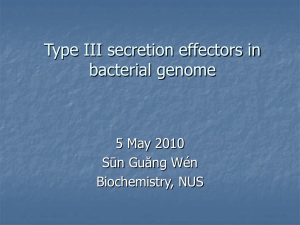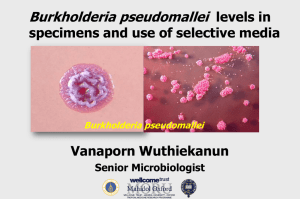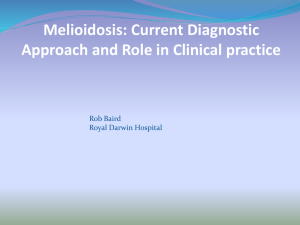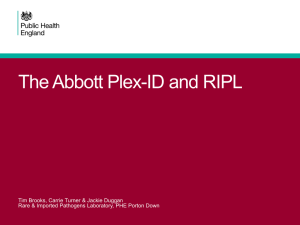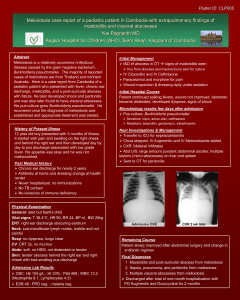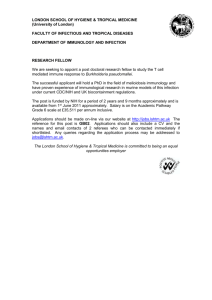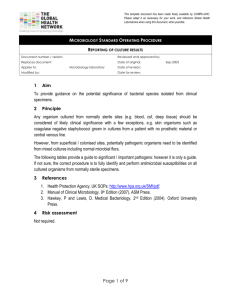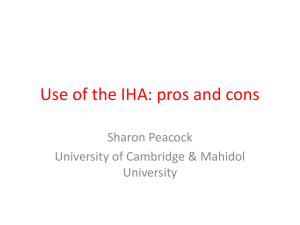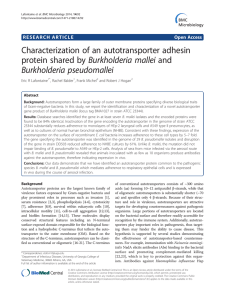Isolation of Burkholderia Pseudomallei from clinical specimens
advertisement
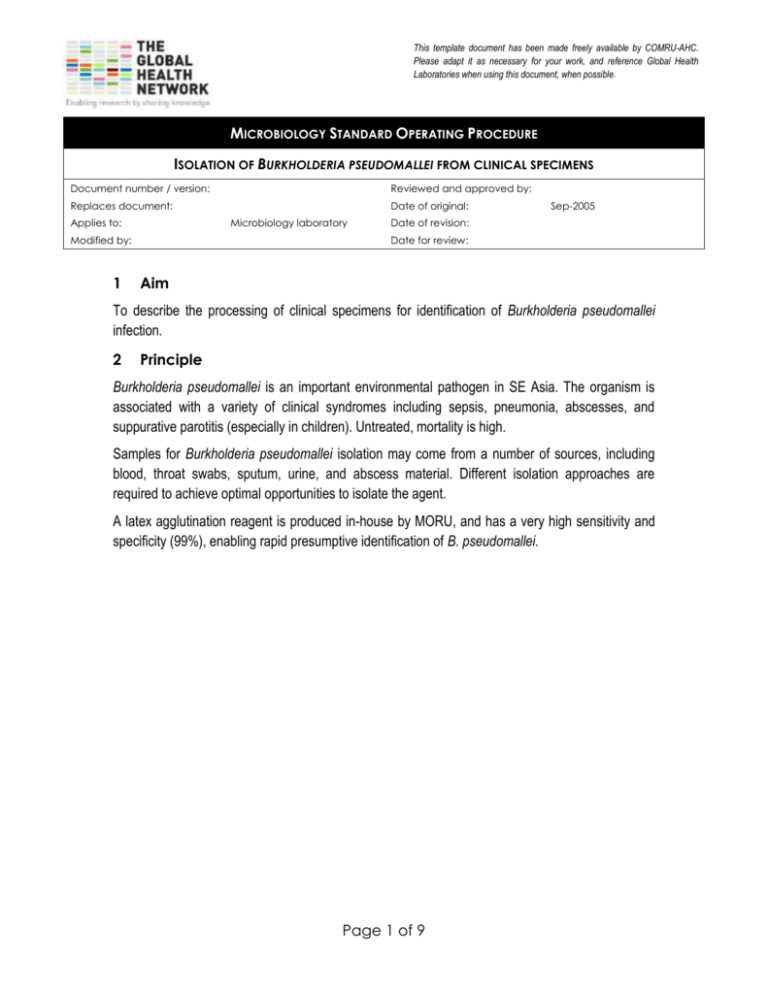
This template document has been made freely available by COMRU-AHC. Please adapt it as necessary for your work, and reference Global Health Laboratories when using this document, when possible. MICROBIOLOGY STANDARD OPERATING PROCEDURE ISOLATION OF BURKHOLDERIA PSEUDOMALLEI FROM CLINICAL SPECIMENS Document number / version: Reviewed and approved by: Replaces document: Date of original: Applies to: Microbiology laboratory Modified by: 1 Sep-2005 Date of revision: Date for review: Aim To describe the processing of clinical specimens for identification of Burkholderia pseudomallei infection. 2 Principle Burkholderia pseudomallei is an important environmental pathogen in SE Asia. The organism is associated with a variety of clinical syndromes including sepsis, pneumonia, abscesses, and suppurative parotitis (especially in children). Untreated, mortality is high. Samples for Burkholderia pseudomallei isolation may come from a number of sources, including blood, throat swabs, sputum, urine, and abscess material. Different isolation approaches are required to achieve optimal opportunities to isolate the agent. A latex agglutination reagent is produced in-house by MORU, and has a very high sensitivity and specificity (99%), enabling rapid presumptive identification of B. pseudomallei. Page 1 of 9 This template document has been made freely available by COMRU-AHC. Please adapt it as necessary for your work, and reference Global Health Laboratories when using this document, when possible. MICROBIOLOGY STANDARD OPERATING PROCEDURE ISOLATION OF BURKHOLDERIA PSEUDOMALLEI FROM CLINICAL SPECIMENS Document number / version: 3 Method 3.1 Pus, sputum, sterile fluids, swabs Inoculate and streak the following media for isolation of B. pseudomallei when the clinical team has melioid culture: Ashdown agar (ASH) Selective Broth for B. pseudomallei (SB) Incubate all plates and broth for 4 days at 35 - 37C inspecting for growth daily. After 48 hours of incubation, subculture selective broth onto Ashdown agar. Incubate this plate for a further 48 hours at 35 - 37C inspecting for growth daily. 3.2 Urine Plate unspun (neat) urine directly half of an Ashdown agar plate using a 1l inoculating loop. Centrifuge the urine at 3,000 rpm for 5 minutes and plate one drop of deposit onto the other half of the plate using a 1l inoculating loop. Streak the plates in three directions (see Urine culture SOP, MIC-006). Incubate the plate for 4 days at 35 - 37C inspecting for growth daily. Follow table 1 for culture result reporting. Table 1. Interpretation of quantitative urine culture Number of colonies in 1L Interpretation / Report 1-9 103 CFU/ml 10-99 10 4 - 105 CFU/ml ≥100 ≥10 5 CFU/ml If colonies are only seen on the side of the spun deposit, report as only seen from the deposit. 3.3 Blood cultures Process blood cultures as described in SOP MIC-003. Identify suspected B. pseudomallei as outlined below. Page 2 of 9 This template document has been made freely available by COMRU-AHC. Please adapt it as necessary for your work, and reference Global Health Laboratories when using this document, when possible. MICROBIOLOGY STANDARD OPERATING PROCEDURE ISOLATION OF BURKHOLDERIA PSEUDOMALLEI FROM CLINICAL SPECIMENS Document number / version: 4 Interpretation 4.1 Identification of Burkholderia pseudomallei 4.1.1 Colony morphology B. pseudomallei colonies on blood agar are typically small, smooth and creamy in the first 48 hours. On further incubation, this appearance changes to give dry, wrinkled colonies. B. pseudomallei is described as producing a distinctive musty or earthy odour, although sniffing of open plates should never be undertaken. The organism is motile, indole negative, oxidase positive, and resistant to colistin and gentamicin, features that aid identification. B. pseudomallei on Ashdown agar appears as very small (pin point) colonies by 18 h, and is usually purple, flat, dry and wrinkled (‘cornflower head’) after 48 hours of incubation. Table 2 describes colony morphology on a variety of media. Page 3 of 9 This template document has been made freely available by COMRU-AHC. Please adapt it as necessary for your work, and reference Global Health Laboratories when using this document, when possible. MICROBIOLOGY STANDARD OPERATING PROCEDURE ISOLATION OF BURKHOLDERIA PSEUDOMALLEI FROM CLINICAL SPECIMENS Document number / version: Table 2. B. pseudomallei colony morphology Time Sheep BA MAC ASH SB Note Incubate at 37C aerobic Incubate at 37C aerobic Incubate at 37oC aerobic Incubate for at least 2 days, read daily Incubate for at least 2 days, read daily Incubate for 4 days, read daily Incubate for 48 hours, then S/C to ASH Weak lactose fermenter, usually flat. May develop sheen Pin point, clear, pale pink with visible sheen May be quite red, flat colonies 1-2 mm, pinkish-purple, flat, slightly dry with metallic sheen 18-24 h ≤ 1mm creamy, coliform-like colonies, ± slight metallic sheen 48 h 3-4 d 1-2 mm, definite metallic sheen, may begin to wrinkle, alpha haemolytic Dry and wrinkled Note: Not necessary if direct plate culture is positive A small, whitish pellicle will develop slowly If seen, perform latex if direct culture was negative Larger, usually dry, deeper purple, more wrinkled. Colonial variants are common, such as mucoid and dry, or different shades of purple Note: Growth is slower if other organisms are present. Growth of a single colony, or colonial variation is common. Page 4 of 9 This template document has been made freely available by COMRU-AHC. Please adapt it as necessary for your work, and reference Global Health Laboratories when using this document, when possible. MICROBIOLOGY STANDARD OPERATING PROCEDURE ISOLATION OF BURKHOLDERIA PSEUDOMALLEI FROM CLINICAL SPECIMENS Document number / version: 4.1.2 Follow-up of suspected B. pseudomallei isolates 4.1.2.1 Latex agglutination test Pipette 2 x 10μl aliquots of latex reagent onto a clean glass slide. Using a toothpick, touch the suspected colony and emulsify in the first latex solution aliquot. Rock the microscope slide to mix and allow the reaction to occur. Observe for agglutination (clumping with clearing of the background): Agglutination may be rapid or may take up to 20 seconds. Observe for at least 2 minutes before reporting the sample as negative. The negative control latex aliquot should remain milky with no clumping: agglutination in this aliquot invalidates the test. Positive Negative Precautions: Burkholderia cepacia might give a false positive latex result. B. cepacia is resistant to amoxicillin/clavulanic acid (AMC) and may be yellow in colour. If in doubt, use API 20NE for confirmation. 4.1.2.2 Further confirmation Set up a TSI slope: B. pseudomallei should be K/NC; no gas; H2S negative. Set up antimicrobial susceptibilities to aid identification (MH agar; 1.0 McFarland inoculum; incubate for 16 – 20h at 35 - 35C in air): AMC, CN, and CT discs: B. pseudomallei should be resistant to CN and CT but susceptible to AMC. If any results are discordant, set up an API 20NE (see SOP MID-002). Page 5 of 9 This template document has been made freely available by COMRU-AHC. Please adapt it as necessary for your work, and reference Global Health Laboratories when using this document, when possible. MICROBIOLOGY STANDARD OPERATING PROCEDURE ISOLATION OF BURKHOLDERIA PSEUDOMALLEI FROM CLINICAL SPECIMENS Document number / version: 4.2 Antimicrobial susceptibility testing All B. pseudomallei isolates should have antimicrobial susceptibilities determined according to SOP MIC-001. 4.3 Reporting At the time of routine culture result reporting, report “B. pseudomallei culture pending”. When all B. pseudomallei culture work is complete, make an additional report stating ether “B. pseudomallei isolated” or “B. pseudomallei NOT isolated”. 5 Quality assurance Media and identification tests should be quality controlled according to the relevant SOP. 6 Limitations Prior antimicrobial use may result in negative cultures. 7 References 1. MORU SOP MBL3.8M. Isolation of Burkholderia pseudomallei from clinical samples (Version 1.3; August 2012). Page 6 of 9 This template document has been made freely available by COMRU-AHC. Please adapt it as necessary for your work, and reference Global Health Laboratories when using this document, when possible. MICROBIOLOGY STANDARD OPERATING PROCEDURE ISOLATION OF BURKHOLDERIA PSEUDOMALLEI FROM CLINICAL SPECIMENS Document number / version: 8 Synopsis / Bench aid Page 7 of 9 This template document has been made freely available by COMRU-AHC. Please adapt it as necessary for your work, and reference Global Health Laboratories when using this document, when possible. MICROBIOLOGY STANDARD OPERATING PROCEDURE ISOLATION OF BURKHOLDERIA PSEUDOMALLEI FROM CLINICAL SPECIMENS Document number / version: Page 8 of 9 This template document has been made freely available by COMRU-AHC. Please adapt it as necessary for your work, and reference Global Health Laboratories when using this document, when possible. MICROBIOLOGY STANDARD OPERATING PROCEDURE ISOLATION OF BURKHOLDERIA PSEUDOMALLEI FROM CLINICAL SPECIMENS Document number / version: 9 Risk assessment COSHH risk assessment - University of Oxford COSHH Assessment Form Description of procedure Culture of Burkholderia pseudomallei from clinical specimens Substances used Variable (may include Gram stain reagents; 3% hydrogen peroxide (catalase test); N,N,N',N'tetramethyl-1,4-phenylenediamine (oxidase test); B. ps latex reagent (MORU); bioMerieux API reagents) Quantities of chemicals used Frequency of SOP use Small Daily Hazards identified Could a less hazardous substance be 1. Autoclaved liquid used instead? 2. Potentially infectious material in sample No 3. Potentially pathogenic bacteria 4. Chemical exposure form bacterial identification tests What measures have you taken to control risk? 1. Training in good laboratory practices (GLP) 2. Appropriate PPE (lab coat, gloves, eye protection) 3. Use of biosafety cabinet for reading of plates / follow-up of B. pseudomallei Checks on control measures Observation and supervision by senior staff Annual certification of biosafety cabinets and annual biosafety audit by MORU staff Is health surveillance required? Training requirements: No GLP Emergency procedures: Waste disposal procedures: 1. Report all incidents to Safety Adviser 1. Sharps discarded into appropriate rigid 2. Use eyewash for splashes containers for incineration 3. Clean up spills using 1% Virkon or 2. Infectious waste discarded into autoclave bags chemical spill kit or 1% Virkon solution prior to autoclaving and subsequent incineration 3. Chemical waste disposed of according to manufacturer’s instructions Page 9 of 9
